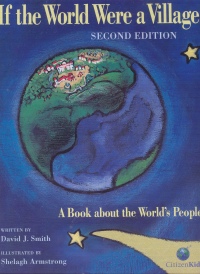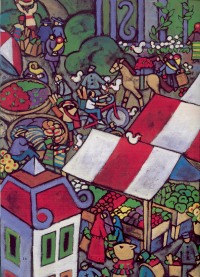| ________________
CM . . . . Volume XVII Number 41 . . . . June 24, 2011
excerpt:
Updated with new content and statistics, the second edition of If the World Were a Village once again asks readers to imagine the world as a village of just 100 inhabitants, with each person representing 69 million people (according to the author there were 6.9 billion people on Earth in 2010). Fourteen chapters cover such topics as nationalities, ages, food, religion, education and health, just to name a few. In the village, the majority of the inhabitants are Asian, under 30 years of age, and practice the Christian or Muslim faith. Not all villagers have "food security" nor do they have clean water or adequate sanitation. There is an inequity in regard to money and material possessions as well, for the richest 10 people have almost 85% of the wealth, and the poorest 10 earn less than two dollars per day and many cannot afford even the most basic needs. In some parts of the village, males are encouraged to go to school while their sisters stay at home. Statistics show that 73% of the villagers rely on fossil fuels for energy and that the world's population has more than tripled in the past 110 years. These, and other trends, have serious implications for the future because at the present rate of growth, the village will not be able to sustain its population. It is estimated that, by the year 2150, the village will have reached its maximum growth, and there could be widespread shortages of food, shelter and resources.
Paring the world's population to a manageable number of 100 for the sake of the reader's better understanding the concepts is a very successful strategy. Most students of the target audience understand fractions or percentages, and they will be able to see very quickly that the lives that they lead in Canada are not at all the norm when compared to the lives of most villagers.
At the back of the book is a double-page spread which provides ideas for teaching children "world-mindedness" in the classroom. These activities range from studying maps and playing geography games to emailing students in other parts of the world to learn about their country and culture and discussing issues, such as world hunger, immigration and different forms of government. Finding opportunities to make global connections is also stressed. A table of contents is included. Drawings are mostly aerial views of the village rendered in vibrant greens and blues, punctuated by red, yellow and white and outlined in black. These chalky pastel looking illustrations draw readers in and invite them to look more closely at the details. If the World Were a Village is part of the "CitizenKid" collection of books that inspire children to learn about the world and to become better global citizens. Thought-provoking, eye-opening and fascinating, this book is sure to spark interesting and meaningful discussion in the classroom and at home. Highly Recommended. Gail Hamilton is Library Learning Resources Consultant at the Instructional Resources Unit, Manitoba Department of Education, in Winnipeg, MB.
To comment
on this title or this review, send mail to cm@umanitoba.ca.
Copyright © the Manitoba Library Association. Reproduction for personal
use is permitted only if this copyright notice is maintained. Any
other reproduction is prohibited without permission.
NEXT REVIEW |
TABLE OF CONTENTS FOR THIS ISSUE
- June 24, 2011.
AUTHORS |
TITLES |
MEDIA REVIEWS |
PROFILES |
BACK ISSUES |
SEARCH |
CMARCHIVE |
HOME |

